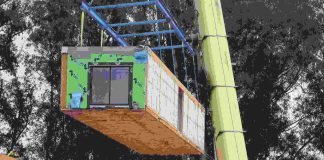By Frank Anderson
Most everyone agrees that Santa Cruz County needs to improve its transportation. We’ve all observed large, virtually empty buses, the lack of a safe bike network, and a rail corridor that has sat unused for decades. All the while, thousands of cars clog our streets and highway. Why? For one, people from all walks of life like cars and rely on them, and our system of roads has been constructed to accommodate the convenience, mobility and privacy that an automobile provides. Ninety-five percent of households own cars. Eighty-five percent of people get to work by car. No one seems to want to ride the bus, unless they have to out of necessity.
The bottom line is this—the more public transportation mimics the advantages of cars the more successful it will be. We can access our cars in our driveways and drive them anywhere in the county where there is a road. A train fails miserably in this regard. One needs to get to the train station, park a car, then take a fixed-rail ride to another station where further transport is needed to get to one’s final destination. A bus can do a better job of getting from a departure point to an end point because it travels on existing roads. And bus fares in the U.S. typically are a third less than train fares.
So how does a community get people to take the bus? How do we improve this vital public transit resource that can provide access to jobs, school, medical care, food and other necessities? For starters, we cannot continue to cut routes and lengthen the time between stops. Routes need to be expanded and frequency increased. The only way to increase bus ridership is to invest in them. Stop spending vital public and Measure D funds on train studies, track maintenance, rail crossings and staff time. We need to go “all in” on our buses. Only then can we begin to see the benefits of improved public transit.
Social equity is a big concern for any public transportation system. Policy should always strive for greater geographical mobility and improved accessibility. It is a fact that trains fall short when it comes to social equity. Middle and upper class people ride trains. The average income of a SMART train rider in Sonoma and Marin is $97,000 per year. The typical Southern California rail commuter is a white male earning $65,000 with a monthly parking subsidy from his employer and ready access to alternative transportation for his first mile/last mile journey. Where commuter train lines are installed, housing costs go up, suburbs are created, and lower income residents are displaced. And, bus service deteriorates. Recent planners with an objective of social equity have started to oppose rail transit options serving suburban communities. They now argue for lower bus fares and expanded service. New fixed rail systems do not increase accessibility and draw resources away from suitable bus services. Rail funding decreases social equity.
Social equity is gained when people of all demographics ride the bus. And the only way to accomplish this is to make bus use more attractive. Some steps are now being taken in Santa Cruz County to help. Bus on Shoulder, basically a dedicated Highway 1 lane for buses only, has been approved and will cut commute times between Watsonville and Santa Cruz. Adaptive Signal Control has also been approved, enabling buses to avoid traffic congestion at lights. Another strategy for increasing bus usage is remote ticket purchasing, which allows for quick entry into either the front or rear of a bus. Free Wi-Fi, improved seating and less operating noise is achievable. We can make riding the bus a better experience.
Of course, it really comes down to how well a bus can compete with an automobile. The more a bus does the things a car can do, the more riders it will attract. We must prioritize bus service for the people who need it most. Neighborhoods need to be serviced on a frequent basis. Bus stops need to be near jobs and services. Fares need to be cheap, or free. Travel times need to be as short as possible. Public outreach through civic organizations and community engagement must be optimized. Let’s decide as a community to put our public investment into improving our bus system, rather than spending resources on an unfunded billion-dollar train system that would benefit the privileged few.
Frank Anderson is Santa Cruz resident and business owner in both Watsonville and Santa Cruz. His views are his own and not necessarily those of the Pajaronian.
The Pajaronian welcomes letters. Letters and columns may be dropped off or mailed to The Pajaronian, 21 Brennan St., Suite 18, Watsonville, CA 95076. Letters and columns may also be sent via email to tn****@********an.com. Letters should be less than 300 words, and columns are no more than 700 words. All letters and columns must be signed and have an address and phone number for confirmation purposes. We reserve the right to edit and condense all submissions.







